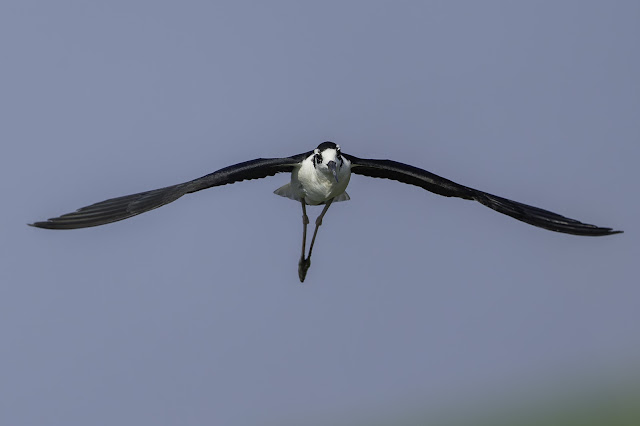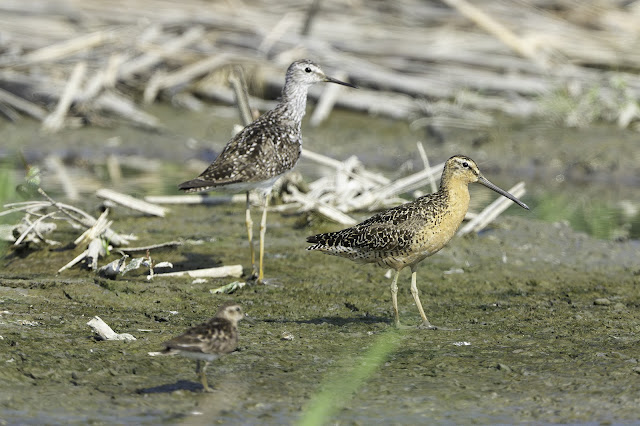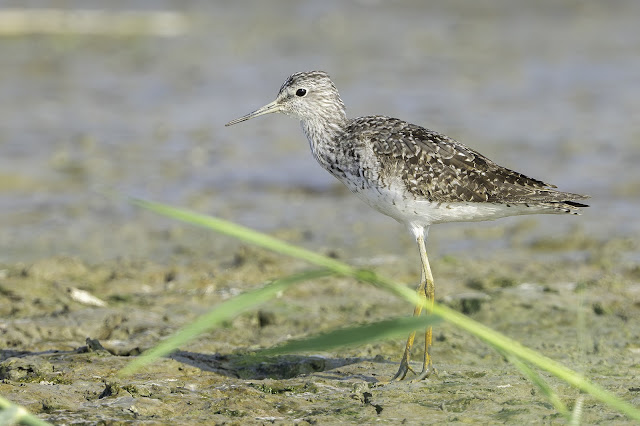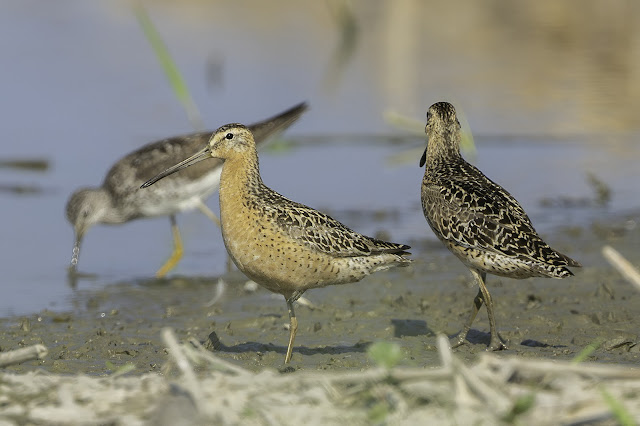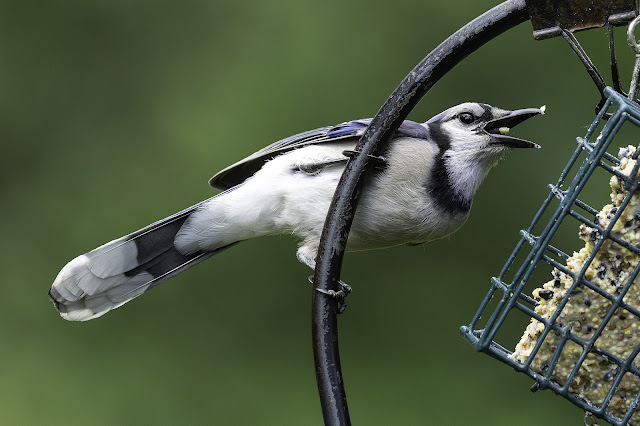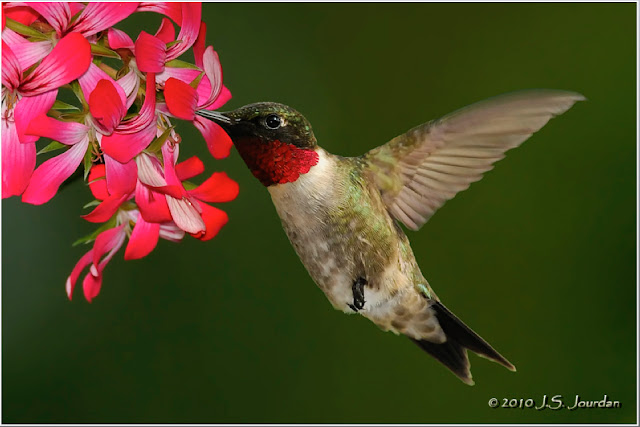Fall Shorebirding is Underway! - 08 Jul 2025
This afternoon I drove to Pt. Mouillee to bike the Banana Unit to Cell 3. It was mostly clear, humid and hot at 81ºF with a light 5-10 mph wind blowing from the SW. Amber Piotter had reported a Yellow-breasted Chat on Roberts Road and shorebirds in Cell 2. It was an opportunity for me to get out and check Cells 2 and 3.
I made a pass down Haggerman Road past the Antenna Farm on the way to Pt. Mouillee. I was disheartened to see that the prairie growing along Haggerman Road to the fence line had just been mowed and another 20 ft inside the fence line was being mowed. Ugh. At least the Dickcissels were still being heard inside the fence line.
As I drove to east end of Haggerman Road I followed an Osprey carrying a carp to the nest at the corner of US Turnpike and Port Sunlight Rd. The other adult was on the nest with at least one chick.
Antenna Farm, Monroe, Michigan, USJul 8, 2025 5:02 PM - 5:06 PM
Protocol: Traveling
0.926 mile(s)
Checklist Comments: Sunny, humid breezy 81F. Crews mowing prairie from Haggerman to fence and 20ft inside.
4 species
Osprey (Pandion haliaetus) 3
Tree Swallow (Tachycineta bicolor) 2
Red-winged Blackbird (Agelaius phoeniceus) 4
Dickcissel (Spiza americana) 3
View this checklist online at https://ebird.org/checklist/S2
This report was generated automatically by eBird v3 (https://ebird.org/home)
I then drove to the north end of Roberts Road and slowly cruised the road southward toward Amber's pin (see Discord) that was located right at the point where the cement road reaches dirt road. The usual Yellow Warblers, Red-winged Blackbirds, Warbling Vireos, and Indigo Buntings were being heard, but the Yellow-breasted Chat was not. So I continued south to the parking lot where I unloaded the bike and headed out onto the South Causeway.
The pond at the NW corner of Cell 1 was quiet except for a pair of Pied-billed Grebes. At the SW corner of Cell 2 the duckweed-covered fluddle was free of shorebirds.
A pair of Common Gallinules were foraging in the open a bit farther north, and as I approached a Solitary Sandpiper flushed. A small flock of Lesser Yellowlegs and Short-billed Dowitchers then flushed from the flooded phragmites and circled a few times before settling down out of site.
As I walked the bike along the length of the fluddle I spotted the first of a pair of Stilt Sandpipers. This one was chumming with a dowitcher and the two seem to be inseparable. They flushed but returned to the same spot together.
Pte. Mouillee SGA (permit required Sep 1-Dec 15), Monroe, Michigan, US
Jul 8, 2025 5:15 PM - 7:21 PM
Protocol: Traveling
5.518 mile(s)
Checklist Comments: Sunny, humid 80F light wind 5mph from SW
47 species
Canada Goose (Branta canadensis) 120
Gadwall (Mareca strepera) 2
Mallard (Anas platyrhynchos) 65
American Black Duck (Anas rubripes) 6 2 in SW corner of Cell 2 and 4 in Cell 3. The two in Cell 2 were males w/ dark bodies, grayish-tan heads and bright yellow bills. The 4 in Cell 3 were together, similar in appearance to the ones in Cell 2, and showed purple speculums when flexing (though not a discrete ID mark the coloration supported the ID).
Green-winged Teal (Anas crecca) 6
Redhead (Aythya americana) 2
Common Gallinule (Gallinula galeata) 3
Black-necked Stilt (Himantopus mexicanus) 6 4 in w side of Cell 2 and pair in Cell 3.
Killdeer (Charadrius vociferus) 13
Short-billed Dowitcher (Limnodromus griseus) 48 Cell 2 with 3 dozen counted in flight and another dozen in Cell 3.
Spotted Sandpiper (Actitis macularius) 2
Solitary Sandpiper (Tringa solitaria) 1
Lesser Yellowlegs (Tringa flavipes) 120
Greater Yellowlegs (Tringa melanoleuca) 1
Stilt Sandpiper (Calidris himantopus) 2
Dunlin (Calidris alpina) 1
Least Sandpiper (Calidris minutilla) 34
Pectoral Sandpiper (Calidris melanotos) 1
Bonaparte's Gull (Chroicocephalus philadelphia) 8
Ring-billed Gull (Larus delawarensis) 450
American Herring Gull (Larus smithsonianus) 120
Caspian Tern (Hydroprogne caspia) 18
Black Tern (Chlidonias niger) 18
Forster's Tern (Sterna forsteri) 15
Common Tern (Sterna hirundo) 3
Pied-billed Grebe (Podilymbus podiceps) 2
Double-crested Cormorant (Nannopterum auritum) 2
Black-crowned Night Heron (Nycticorax nycticorax) 1
Great Egret (Ardea alba) 2
Great Blue Heron (Ardea herodias) 4
American White Pelican (Pelecanus erythrorhynchos) 1
Osprey (Pandion haliaetus) 3
Willow Flycatcher (Empidonax traillii) 1
Eastern Kingbird (Tyrannus tyrannus) 2
Warbling Vireo (Vireo gilvus) 2
Tree Swallow (Tachycineta bicolor) 2
Purple Martin (Progne subis) 2
Barn Swallow (Hirundo rustica) 2
Northern House Wren (Troglodytes aedon) 1
European Starling (Sturnus vulgaris) 8
American Robin (Turdus migratorius) 2
American Goldfinch (Spinus tristis) 1
Song Sparrow (Melospiza melodia) 1
Red-winged Blackbird (Agelaius phoeniceus) 34
Common Yellowthroat (Geothlypis trichas) 2
Yellow Warbler (Setophaga petechia) 1
Indigo Bunting (Passerina cyanea) 4
View this checklist online at https://ebird.org/checklist/S2
This report was generated automatically by eBird v3 (https://ebird.org/home)
























